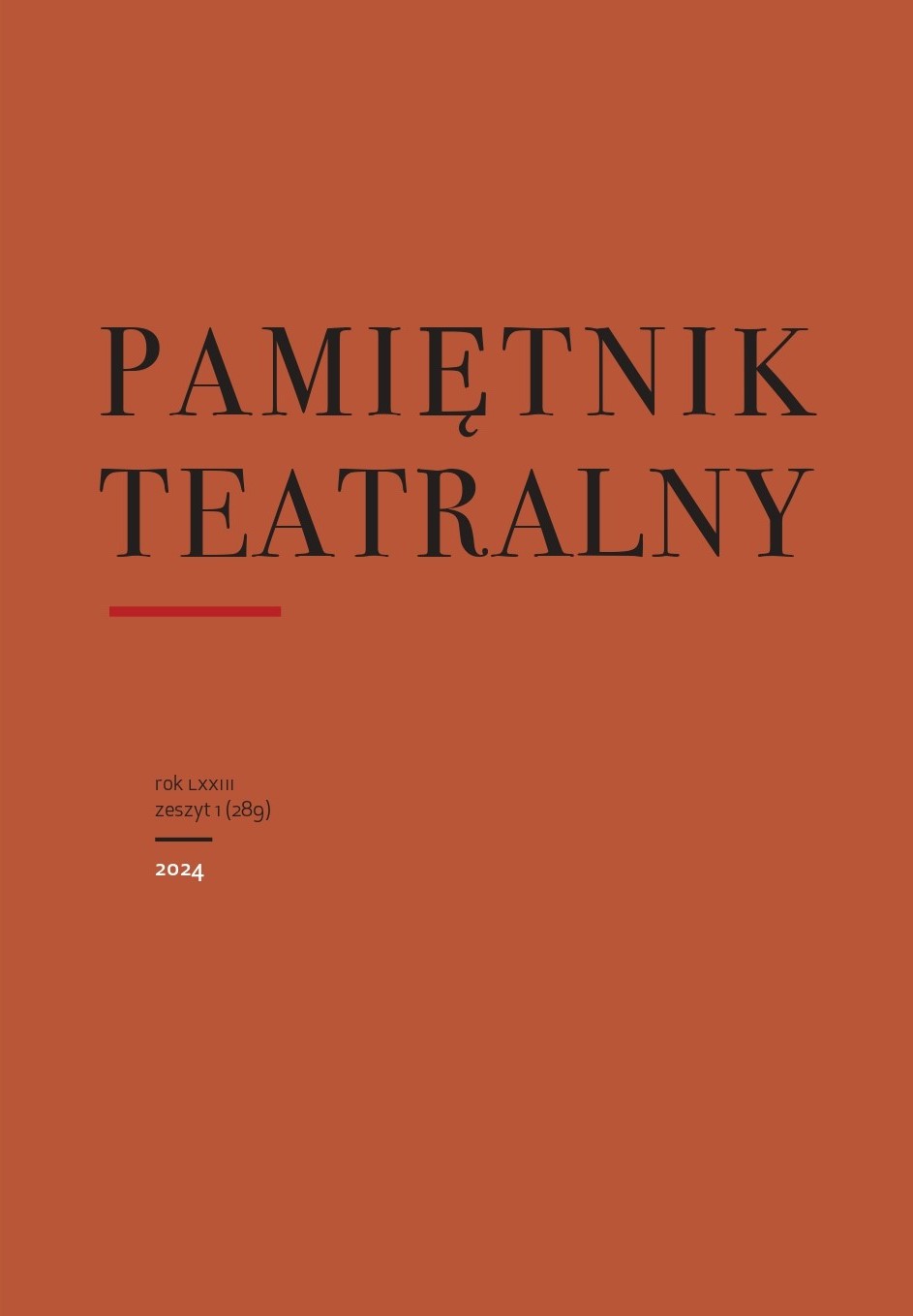The Saxon Opera House in Warsaw
Barbara Król
Institute of Art, Polish Academy of Sciences (Poland)
Abstract
The article discusses the history of the first free-standing purpose-built theater edifice in Warsaw, which, from 1725 to 1772, hosted performances by dell’arte troupes and the Dresden Opera, as well as the first permanent ensemble of Polish actors. The author refers to the scant research on this building (known as the Royal Opernhauz, Operalnia, or Saxon Theater), focusing on the findings of Martin Hammitzsch, Mieczysław Rulikowski, and Kazimierz Konarski. Based on an analysis of ten drawings and plans of the building from Dresden archives (Institut für Denkmalpflege and Landeshauptarchiv), which are reproduced in the article, she challenges Hammitzsch’s dating of the edifice in 1748 and suggests that its construction was completed as early as 1725. She also disagrees with the claim that Giuseppe Galli Bibiena, Matthäus Daniel Pöppelmann or Joachim Daniel Jauch were involved in designing the Saxon Opera House. The name of the architect remains unknown; however, it is clear that he must have been strongly influenced by the Dresden art scene, as there is a noticeable similarity between the Warsaw theater and the Kleiner Komedienhaus in Dresden. The article also discusses the available material concerning the reconstruction of the edifice in 1748, which was probably limited to the renovation of the interior and perhaps also the façade, the redecoration of the auditorium, and technical improvements to the stage. The architectural solutions used in the Opera House had a significant impact on the development of theater stages in Poland.
Keywords:
Polish theater 1700–1800, theater architecture, court theater, public theaterReferences
Batowski, Zygmunt. „Kto jest autorem obrazu „Chrystus na Krzyżu“ w kościele św. Krzyża w Warszawie?”. Dawna Sztuka 1, z. 2 (1938): 131–144.
Google Scholar
Hammitzsch, Martin. Der moderne Theaterbau. Teil 1. Der höfische Theaterbau, der Anfang der modernen Theaterbaukunst, ihre Entwicklung und Betätigung zur Zeit der Renaissance, des Barock und des Rokoko. Berlin: Verlag nicht ermittelbar, 1906.
Google Scholar
Heckmann, Hermann. M. D. Pöppelmann als Zeichner. Dresden: Verlag der Kunst, 1954.
Google Scholar
Husarski, Wacław. „Jan Joachim Daniel Jauch dyrektor budowli za czasów saskich”. Prace Komisji Historii Sztuki 2, z. 1 (1922): 57–58.
Google Scholar
Hyatt-Mayor, Alpheus. The Bibiena Family. London: H. Bittner and Company, 1945.
DOI: https://doi.org/10.2307/3257247
Google Scholar
Kitowicz, Jędrzej. Opis obyczajów za panowania Augusta III. Opracowanie Roman Pollak. Wrocław: Wydawnictwo Zakładu Naukowego im. Ossolińskich, 1951.
Google Scholar
Konarski, Kazimierz. „Teatr warszawski w dobie saskiej”. Pamiętnik Teatralny 1, z. 2/3 (1952): 15–36.
Google Scholar
Korzeniewski, Bohdan. „Komedia dell’arte w Warszawie”. Pamiętnik Teatralny 3, z. 3/4 (1954): 29–56. https://doi.org/10.36744/pt.1512.
DOI: https://doi.org/10.36744/pt.1512
Google Scholar
Korzeniewski, Bohdan. „Teatr francuski w Warszawie za Augusta III”. Pamiętnik Teatralny 5, z. 1 (1956): 95–101.
DOI: https://doi.org/10.36744/pt.1524
Google Scholar
Prosnak, Jan. Kultura muzyczna Warszawy XVIII wieku. Kraków: Państwowe Wydawnictwa Muzyczne, 1955.
Google Scholar
Rulikowski, Mieczysław. „Otwarcie teatru w Warszawie”, Sfinks, nr 7/8 (1915): 6–11.
Google Scholar
Wierzbicka, Karyna. Źródła do historii teatru warszawskiego od roku 1762 do roku 1883. Wrocław: Zakład Narodowy im. Ossolińskich, 1951.
Google Scholar
Wierzbicka, Karyna. Życie teatralne w Warszawie za Stanisława Augusta. Warszawa: Towarzystwo Miłośników Historii, 1949.
Google Scholar
Windakiewicz, Stanisław. Teatr polski przed powstaniem sceny narodowej. Kraków: Krakowska Spółka Wydawnicza, 1921. https://pbc.gda.pl/dlibra/doccontent?id=11300.
Google Scholar
Authors
Barbara KrólInstitute of Art, Polish Academy of Sciences Poland
Barbara Król-Kaczorowska (1922-1992) - theater historian, outstanding expert on theater architecture, author of many books on theater buildings, stage decorations, costumes, and stage machinery.
Statistics
Abstract views: 340PDF downloads: 256
License
Copyright (c) 2023 Barbara Król

This work is licensed under a Creative Commons Attribution 4.0 International License.
The author grants a royalty-free nonexclusive license (CC BY 4.0) to use the article in Pamiętnik Teatralny, retains full copyright, and agrees to identify the work as first having been published in Pamiętnik Teatralny should it be published or used again (download licence agreement). By submitting an article the author agrees to make it available under CC BY 4.0 license.
From issue 1/2018 to 3/2022 all articles were published under a Creative Commons license CC BY-NC-ND 4.0. During this period the authors granted a royalty-free nonexclusive license (CC BY-ND 4.0) to use their article in Pamiętnik Teatralny, retained full copyright, and agreed to identify the work as first having been published in our journal should it be published or used again.









